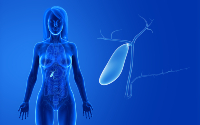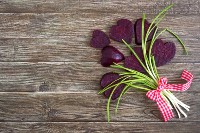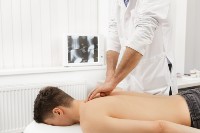August 2020 Edition
What’s New
Beetroots can lower blood pressure, which may lead to reduced risk of heart disease and other ailments. This root veggie can also improve oxygen use, stamina, and exercise performance.
What Your Gallbladder Does and How to Keep it Healthy

On the right side of your abdomen, just under the ribcage, is the gallbladder. A small pear-shaped organ, it supports the body’s detoxification process and, working with other organs, is crucial to the digestion of certain foods, particularly fatty foods.
The gallbladder connects to the liver and small intestine via ducts that transport bile (a yellowish-green liquid secreted by the liver). Together, the gallbladder and these ducts are known as the biliary system. Bile contains water, cholesterol, lipids (fats), salts, and bilirubin (the pigment that gives bile and stools their color). A healthy gallbladder stores and concentrates bile, secreting it into the small intestine through the bile duct during the digestive process. Once in the small intestine, bile helps digest fat.
Causes of Gallbladder Dysfunction
An unhealthy gallbladder can result in problems with both digestion and detoxification and can be attributed to a number of causes including:
• Unhealthy diet and lifestyle habits
• Excessive stress
• Gastrointestinal illness
• Obesity
• Nerve degeneration
• Inflammation
• Hypothyroidism and hormone dysregulation
• Anatomical abnormalities
Gallbladder Conditions
Hyperkinetic Biliary Dyskinesia: The gallbladder contracts too frequently. This causes extreme pain that feels like it is emerging from the heart. Symptoms include increased heart rate, decreased muscle strength, and elevated pressure in the gallbladder.
Hypokinetic Biliary Dyskinesia: The gallbladder does not contract frequently enough (more common condition than above). Symptoms include pain in the upper right abdomen after eating a high-fat meal, as well as indigestion, nausea, vomiting, bloating and fatigue. Pain and cramping does not subside when gas is passed or by a bowel movement.
Cholelithiasis: Caused by gallstones becoming lodged in ducts and blocking the flow of bile. Gallstones develop when substances in the bile, primarily cholesterol and bile pigments, form hard, crystal-like particles. These “stones” can be incredibly small or as large as the gallbladder itself.
The most common symptom of gallstones is intermittent abdominal pain and spasm in the right upper abdomen (may also be felt in the back and right shoulder). Other symptoms include nausea, vomiting, and intolerance to fatty foods. Recurrent duct blockages can lead to a total obstruction that results in significant fever and requires immediate medical attention. Other complications include jaundice, a yellow discoloration of the skin and eyes; infection of the bile ducts; and inflammation of the pancreas. If the bile duct remains blocked for a long period of time, irreversible liver damage may occur.
If the gallbladder is removed, the body does not have a way to efficiently digest fats. Ox bile (or another bile salt) is a common supplement used to support the digestion of fats in people who do not have a gallbladder.
Maintain a Healthy Gallbladder:
Commit to a diet high in fiber, low in hydrogenated fats, along with fresh whole fruits and vegetables. If you are at risk for gallbladder disease, consider these dietary adjustments:
• Choose oats, brown rice, quinoa, or barley for healthy fiber sources
• Drink plenty of water throughout the day
• Exercise regularly; walk leisurely after meals to facilitate digestion
• Sit-up while eating; consider adjusting timing and frequency of meals
• Chew foods well and take your time eating
• Choose lean cuts of meat and poultry. Prepare meat in a way that allows fat/grease to drip away. Remove the skin from poultry
• Include more fish in your weekly menu
• Avoid processed food and foods containing trans-fatty acids and highly processed oils
• Include healthy oils such as olive oil, coconut oil, and avocado oil
• Trade dairy products for non-dairy milk, cheese and yogurt
• Take digestive support supplements, such as enzymes or ox bile
Dietary changes are unique to everyone so it is important to discuss your needs with a holistic health practitioner like Dr. Samm who specializes in clinical nutrition and can customize a diet and nutritional supplement plan for you.
Food for Thought. . .
“Adopt the pace of nature. Her secret is patience.” – Ralph Waldo Emerson
Beautiful Beets

Any way you slice them, beets are a versatile part of a healthy diet. They contain a variety of vitamins and minerals, including several of the B vitamins, vitamin C zinc, selenium, manganese, phosphorus. Also rich in antioxidants (lutein, betalain, and zeaxanthin), beets support the body’s ability to eliminate toxins and free radicals. Like most nutrient-dense veggies, beets support the immune system and are potent staples in an anti-inflammatory diet.
Since beets are also rich in fiber, including them in your diet helps support a healthy digestive system and can prevent common problems like indigestion and constipation. Just don’t be surprised to see a reddish pigment in your stool or urine. (If that persists when not eating beets, it’s best to consult your doctor).
In addition to purple, beets come in red, gold, and pink. When selecting beets, opt for organic whenever possible. Look for small or medium-sized roots. Skins should be smooth and evenly colored. Beet greens or roots might look a little beat up, but they are quite hardy. Avoid choosing beets that show dark spots, bruises or wet areas, which indicate the vegetable is rotting.
Generally, you’ll want to use the beets soon after bringing them home. From the plump, juicy, bulb, to the root and greens, there are a number of ways to add this veggie to a meal and reap the health benefits. Slice up beets for salads or as an addition to yogurt. Roast them or dice them into a stir fry (adding at the very end).
If you have a large number of beets or aren’t using them right away, check out these tips for storage of the bulb and greens, from Harvest to Table.
Beet and Goat Cheese Salad w/ Walnuts and Quinoa

This delicious root vegetable is versatile, nutritious, and easy to prepare. Enjoy it as a main course or side salad. It goes particularly well with a healthy entree (we suggest grilled fish). It’s also sure to be a hit at a picnic.
Ingredients for the Salad
• 30 – 45oz canned whole beets or 1# beets (2 1/2-3″) for roasting*
• 5 oz baby arugula or mixed greens (4 cups)
•1/2 cup shredded carrots
• 1/2 cup quinoa
• 4 oz goat cheese
• 1/2 cup chopped walnuts
*Most people opt to use canned beets for this recipe, but if you would like to roast them, do that first. Instructions are below.
Ingredients for the Vinaigrette
• 1/2 cup EVOO
• 1/4 cup Balsamic vinegar
• 1 Tbs Dijon mustard
• 1/8 tsp kosher salt
Freshly ground black pepper to taste
Preparation:
- Cook quinoa in boiling, salted water for 8-11 minutes. Drain well and cool. (Quinoa can be made up to 24 hrs ahead).
- Drain and dry canned beets, or if using roasted beets, cool and peel. Cut beets into bite-sized pieces. Tip: put a sheet of parchment paper on your cutting board to prevent staining.
- Using a small bowl, whisk ingredients for the vinaigrette together and set aside.
- In a separate bowl, combine cut beets and 1/4 cup of the dressing. Toss to coat. Let beets marinate at room temperature for 15-20 minutes.
- Place greens, shredded carrots and 1/2 cup cooked quinoa in a salad bowl and toss with dressing to taste.
- Arrange tossed salad on plates or platter. Top with marinated beets, then sprinkle with the walnuts and goat cheese. Serve immediately.
To roast beets:
• Set the oven rack in the center position. Preheat oven to 400 degrees F.
• Trim the tops off the beets, leaving 1/2 inch of the stem. Wash and scrub dirt from the beets and dry well.
• Rub with olive oil and sprinkle with salt and pepper. Wrap the beets tightly in aluminum foil and place on a sheet tray.
• Roast the beets until fork-tender, about 40 to 60 minutes, time will vary depending on the size of the beets. Check every 20 minutes for doneness.
• Allow beets to cool, peel and cut into 1/2-inch wedges.
The Golden Nutraceutical: Turmeric

The golden-orange spice that lends pizazz to curries and mustards comes from turmeric, an herb with numerous health benefits. Turmeric (Curcuma longa) contains curcumin, a biologically active compound known for its antimicrobial, antioxidant, and anti-inflammatory properties. Traditional Indian and Chinese Medicine practitioners use various forms of turmeric when treating conditions such as heartburn, digestive ailments, arthritis, and chronic pain. Numerous modern studies indicate that curcumin is also active against chronic diseases in which inflammation plays a significant role, including diabetes, obesity-related health complications, irritable bowel syndrome, some types of cancer, cardiovascular, autoimmune, and digestive diseases.
Research shows that curcumin blocks inflammatory enzymes at the cellular level in a natural, gentle, and effective manner. When inflammation in the digestive tract is reduced, the gallbladder can better carry out its important function in the digestive process. For instance, obesity is associated with digestive diseases and various cancers including gallbladder cancer. Studies indicate that curcumin has therapeutic value in the treatment and prevention of obesity-related cancers. Studies have also shown promising, but not conclusive, results for curcumin’s effects on gallstones.
While dietary intake of turmeric is not likely to reach therapeutic levels in terms of disease treatment, including turmeric liberally in your diet may provide digestive health benefits. For example, sprinkle turmeric over soup, yogurt, roasted veggies, or eggs. To help your body maximize absorption of turmeric’s key compounds, add it to healthy fats such as olive oil, an omelette, lean meat, or fish while they are warming.
If you are interested in exploring turmeric for a medical concern, speak to your holistic health provider like Dr. Samm Pryce about the appropriate nutritional supplement for your needs. Turmeric extract is prepared in capsule, powder, or tea form and taken at different doses for different medical needs. Your practitioner will be able to recommend a supplement that has the best bioavailability to be properly absorbed through the digestive tract.
Support Digestive Health with Ox Bile

Before we can talk about what an ox bile supplement is and why you might consider taking it, you have to know a little something about bile. Bile is a greenish-yellow fluid produced by the liver and stored in the gallbladder. In your intestine, bile makes it easier to digest food that contains fat; it also helps the body eliminate waste products and absorb vitamins A, E, D, and K. Bile also helps dissolve gallstones.
Ox bile works in the body the same way as the bile that is naturally produced by your liver. However, it must be taken at very specific times. A holistic health practitioner like Dr. Samm Pryce is the best person to speak with about using an ox bile supplement, to ensure that you receive the right dose and schedule for taking it.
Manipulative Therapy for Gallbladder Dysfunction

If you’re suffering from gallbladder dysfunction, consider the benefits of manipulative therapy; it’s a hands-on method of manipulating the soft tissue and/or bony structures associated with a specific region of the body, as well as the pathways that innervate and nourish that region. Often combined with manual therapy (soft tissue therapy that focuses on massage and trigger points), manipulative therapy is aimed at normalizing structural and functional processes in the body that are under stress. By helping the body move toward more balanced function, it can relieve symptoms of disease, including gallbladder dysfunction.
Gallbladder dysfunction is characterized by the inability of certain parts of the biliary system to facilitate the normal flow of bile from the liver to the gallbladder for storage and concentration. A disturbance in the system can stem from a neural or hormonal signaling problem or inability of the gallbladder to contract. This causes problems with the ejection of bile from the gallbladder — either too slow or too fast – and can lead to varying symptoms depending upon the individual. Manipulative Therapy helps regulate the bile flow by removing blocks in the signaling pathways and/or supporting the healthy contraction of the gallbladder.
Manipulative therapy can be safe, effective and beneficial for many patients. It can potentially eliminate the need for more invasive treatments, including surgery. Make sure that you choose a physician (not a physical therapist or massage therapist) like Dr. Samm Pryce who specializes in manipulation and gallbladder conditions.
Guiding Principles







